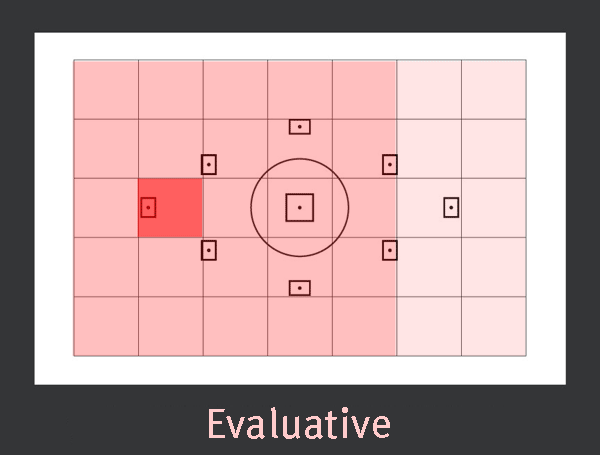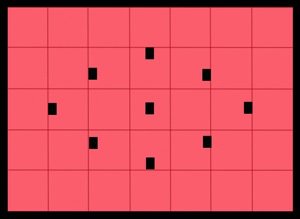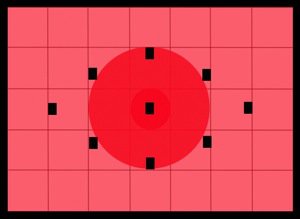LIGHT METER - An instrument that measures the amount of light
falling on a subject or emitted or reflected by a subject allowing aperture
and shutter speed settings to be computed.
Most SLR cameras are equipped with a cadmium Sulfide cell light meter
which operates on batteries. Light
hitting this cell generate an electric current. The more intense the light source the greater the current generated.
Older light meters operate with a Selenium cell. Thess are not very sensitive to dim light.
Four different types of light meters:
- Evaluative:
Metering is directly linked to, and concentrated on, the area around the active AF point, whether you’ve focused on something in the center or off-center. Light values measured at the active AF point are compared with light values measured from the metering segments across the remaining areas of the scene, and the camera's metering system attempts to provide an accurate exposure based on that comparison. This metering pattern is often effective when photographing people, but may not be quite as effective when photographing snowy landscapes depending on other elements in the scene. Note that because Evaluative Metering is linked to active AF points, focusing on a different subject may result in a very different exposure — even within the same scene. Note: In the simulated viewfinder, Evaluative mode is shown with the left-most AF point active. - Spot:
The most selective metering option, it reads exposure information only from the single exposure zone in the center of the frame (approximately 3% of the total picture area) - Partial:
Similar to Spot Metering, but covers a somewhat larger area, reading only the cross-shaped central five metering zones (approximately 10% of the total picture area) — some shooters think of it as a “fat spot” - Center-weighted Average:
This metering mode averages the exposure for the entire metering area, but with greater emphasis on the center metering zones. Unlike Evaluative metering, it does not compare brightness readings from different parts of the scene; it simply reads overall brightness.
Evaluative Meter |
Center Weighted |
Spot Meter |
|---|

-To operate properly a light meter must be set at the proper ISO (film speed)!!
-
Incident-Light Meters measure the light falling on a subject and are generally hand held.
-
Incident meters are generally more accurate than reflective, but the photographer must be able to place the meter next to the subject to achieve a proper reading.
-
Reflective-Light Meters measure the light emitted by or reflected from the subject. In camera meters are Reflective.
On an in-camera meter there will be a window within your focusing frame which will be read by the meter. This window is generally in the center.
-A light meter is only a measuring device, it cannot interpret what it reads. It simply averages each scene to 18% Gray. If your scene is not average then you will need to interpret using your knowledge of a scene
18% gray can be expressed
as average lighting or 50% light 50% dark.
it is expressed as 18% because most objects absorb light.
the majority of surfaces and textures in a picture(grass, trees,
skin, cloth, ect.) reflect between 5% and 31%; the average isa computed
at 18%.
LIGHT METER PROBLEMS
1)if you are metering a primarily dark scene then your meter will give an overexposed reading.
-
to compensate a photographer may "underexpose" one or two stops
2)if you are metering a light scene then your meter will give an underexposed reading.
-
to compensate a photographer may "overexpose" one or two stops
3)if you are only interested in one portion of a scene the meter may react to other portions
-
to compensate a photographer can meter only the important portions of a scene rather than the entire scene
-
make sure that you do not block any light from the subject when you meter this way
-To compensate for other problems a photographer may:
-
meter from an 18% Gray card
-
take a substitute reading from an 18% Gray equivalent such as skin or faded blue jeans
- take a reading from the most important portion of the photograph (see example 3 above
-
guage using your knowledge of the scene whether it needs more or less exposure than the meter is reading. (see examples 1 and 2 above)
BRACKETING EXPOSURES - Bracketing is a term used to describe a safety technique used by many photographers. This involves taking more than one exposure of each important shot. In most cases a photographer will overexpose one shot, underexpose one shot, and take one which he/she believes to be exactly correct. In this way a photographer has a safety net just in case things go slightly wrong. This can also prevent tragic mishaps such as scratched negatives, or momentary compositional flaws (such as a kid picking his/her nose) from ruining a great picture.


